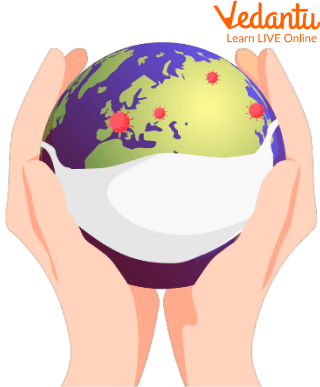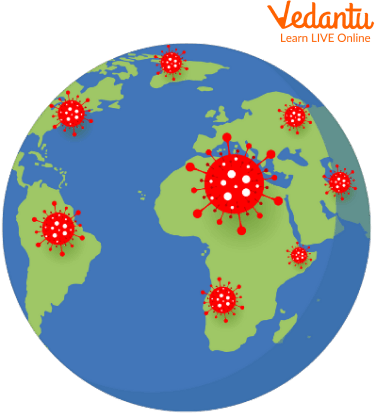Essential Epidemic Disaster Terms for Biology Students
We have all heard the term epidemic a lot in our lives, not in a very positive light. A disease outbreak that quickly spreads to a large population is referred to as an epidemic. A pandemic is what we call an outbreak that spreads widely. A disease can spread from person to person during an epidemic, or it could be spread to people by a non-human entity, such as an insect or polluted water. Let’s learn more about the causes of an epidemic.
What is an Epidemic?
Throughout human history, numerous terrible epidemics have occurred. About 25 million people were murdered by the plague in Europe in the 1300s. It earned the nickname "Black Death." For the following 300 years or so, there were occasional outbreaks of the plague in European cities. The terrible influenza (flu) pandemic occurred from 1918–19. Around the world, more than 20 million people passed away.
The frequency of epidemics has decreased over time. Better healthcare and cleaner living circumstances have slowed the spread of illnesses. However, cholera and malaria epidemics still occur in various places of the world. AIDS first emerged in the 1980s and spread quickly, particularly in Africa. A flu-like condition known as SARS emerged widespread in 2003. Within a few months, SARS spread from Asia to every continent. A disease known as COVID-19 was caused in 2019 by a novel virus type. In a short period, it also spread over the globe.

Epidemic Study
Types of Epidemics
Depending on where the infection comes from and how it spreads, there are several sorts of epidemics.
1. Common Source Outbreaks
Common source outbreaks happen when there is an increase in infection cases following contact with a common dangerous source of infection, such as contaminated food or water, among a group of people.
2. Propagated or Progressive Epidemics
When the sickness spreads from person to person, certain things happen. Infectious agents that spread disease from one host to another can do so directly between individuals, indirectly through vectors (such as mosquitoes in the case of malaria), in water, food, or other environments.
3. Mixed Epidemics
Both shared source and spread epidemic traits are present. Thus, a mixed epidemic may have a common source at first and then spread by transmission. Foodborne infectious organisms are frequently to blame for mixed outbreaks.

Concept of Epidemic
What are the Causes of Epidemic Disasters?
Infectious illness epidemics are typically brought on by several circumstances, such as:
Infections that spread from person to person, from animal to human, via the environment or through other media typically produce disease outbreaks.
At certain times of the year, specific epidemics happen. Whooping cough, for instance, occurs in the spring, whereas measles has two epidemics: one in the winter and one in the spring. In winter, influenza, the common cold, and other upper respiratory tract diseases like sore throat are most prevalent.
Infected food sources, such as toxic water, and the movement of specific animal populations, like rats or mosquitoes, which can serve as disease vectors, are other factors that affect how epidemics break out.
An epidemic often starts when the transmission threshold is reached, and host resistance to either an established pathogen or a newly developing novel pathogen abruptly decreases below that found in the equilibrium state.
The nature of the host population changes (For e.g. increased stress or increase in the density of a vector species).
Introducing a developing disease to a host population or altering the genetic makeup of the pathogen reservoir (by the movement of the pathogen or host).

The Spread of Pandemic
Summary
In this article, we have learnt about epidemics, their types and their causes. An epidemic occurs when a disease spreads quickly through a population, affecting many people in a limited amount of time.
Infectious illness epidemics are typically brought on by several circumstances, such as a large change in the local population's environment, an emerging pathogen's arrival, or an unexpected genetic shift in the bacterium pool. Epidemics typically have to do with how illnesses grow. When immunity to a well-known disease or a recently discovered novel disease is suddenly dropped below that observed in the equilibrium time, and the transmission barrier is exceeded, an epidemic may result.


FAQs on Epidemic Disaster: Meaning, Causes & Impact
1. What is an epidemic disaster?
An epidemic disaster refers to the sudden and widespread occurrence of a disease in a particular community or region, significantly exceeding what is normally expected. It becomes a 'disaster' when its scale and severity overwhelm the community's capacity to cope, leading to significant health crises, social disruption, and economic losses.
2. What are some examples of diseases that have caused epidemics?
Throughout history, several diseases have led to major epidemics. Some notable examples include:
- Cholera: Often spreads through contaminated water, causing severe epidemics in areas with poor sanitation.
- Measles: A highly contagious viral disease that can cause epidemics in populations with low vaccination rates.
- Yellow Fever: A viral disease transmitted by mosquitoes, which has caused devastating epidemics in Africa and the Americas.
- Smallpox: A severe viral disease that caused numerous epidemics before being eradicated globally through vaccination.
3. What is the difference between an epidemic, a pandemic, and an endemic disease?
These terms describe the scale of a disease outbreak, but they are not interchangeable. The key difference is the geographical spread:
- Endemic: The disease has a constant, predictable presence within a specific population or region. For example, malaria is endemic to certain tropical areas.
- Epidemic: There is a sudden, sharp increase in disease cases above the normal level in a region.
- Pandemic: The epidemic spreads across multiple countries or continents, affecting a large number of people worldwide.
4. What are the main factors that can cause an epidemic?
An epidemic can be triggered by a combination of factors. The primary causes include:
- The introduction of a new or mutated pathogen to which people have little or no immunity.
- Poor sanitation and hygiene, which allows germs to spread easily.
- Increased contact between humans and infected animals (zoonotic transmission).
- A breakdown in public health measures, such as a drop in vaccination rates.
- Movement of infected people to new, unexposed areas.
5. Why is an epidemic considered a 'disaster' and not just a health issue?
An epidemic is considered a disaster because its impact extends far beyond just making people sick. It disrupts the very fabric of society by causing:
- Economic Breakdown: Businesses and industries may shut down, and trade can be severely restricted.
- Social Disruption: Schools close, public services are strained, and fear can lead to social unrest.
- Overwhelmed Infrastructure: Hospitals and healthcare facilities become unable to handle the sheer number of patients, affecting care for all other medical conditions.
6. How do authorities know when an epidemic is officially over?
An epidemic is generally considered over when the number of new cases of the disease drops back to a normal or baseline level, known as the endemic rate. Health officials monitor the rate of transmission closely. The outbreak is declared over after a specific period (often two full incubation periods of the disease) has passed with no new cases being reported.
7. Can an epidemic be a 'natural' disaster?
Yes, in a way. While a virus or bacterium is a natural biological agent, an epidemic is often called a 'bio-physical' or 'natural' disaster. This is because, like a hurricane or earthquake, it is a natural phenomenon that can cause widespread damage and suffering, overwhelming a society's ability to manage the consequences on its own.










